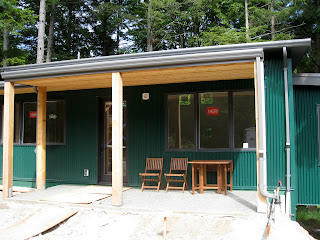Brian, the cabinet maker who works for
South Shore Cabinetry, places the 'Lego' blocks, shims them until level and then makes the finishing details.
Wet station on the left. Electrical station on the right. Looking good.
Then the Lego blocks get moved out of the way so the plumber can do his thing.
The electrician visited and installed the heating - 2 tangential fan units either side of the design wall. They are connected to a thermostat so they can be set to come on automatically. I will also have a remote starter connected to my cell phone so I can turn on the heaters while I am in the house having my breakfast so the studio will be warm when I get out there.
The sunny room has a small wall-mounted radiant electric heater.
We had 2 different companies do heat modeling to find out how much heating capacity would need to be installed. We initially had thought the obvious heating method was going to be a heat pump, but the modeling said otherwise.
The building has 8" thick walls and is well insulated. It is designed to capture solar heating and store it in the concrete foundations. The windows allow heat in but release it very slowly. I will be using heating appliances such as my 2 irons and a hot plate and there are lots of overhead lights, which will all contribute to heating the air within the studio. We have mild winters on the island with very little snow. The modeling covered conditions to minus 10C, which we didn't reach last winter.
Results of the modeling showed extra heating may be needed for a few days over winter and the 2 wall mounted electrical heaters with fans and the one radiant heater would be all that was needed. The cost of a heat pump purchase, installation, maintenance and replacement was a long way off from being justified economically or environmentally.
This is an exciting thing to be happening. Adrian Shewchuk, the owner of
atelier design + build , dropped off the flooring underlay panels. They need to be kept inside the studio for at least a week to adjust to the moisture level inside. Ron has kept the dehumidifier going and it continues to extract buckets full of water. He does regular checks with his moisture reading tool hoping to see a drop in the plywood floor moisture levels. It looks as though water is now being drawn up from the crawlspace so the dehumidifier gets moved downstairs every few days, then back upstairs.


















































